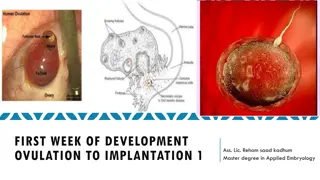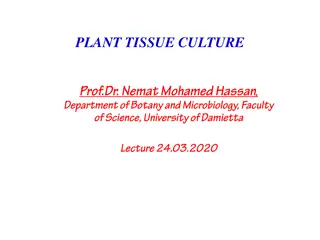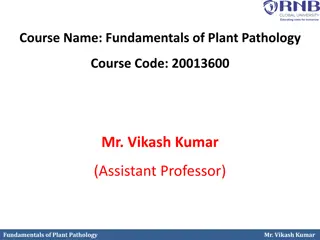Understanding Plant Embryogenesis: A Comprehensive Overview
Plant embryogenesis is a crucial process in the development of plant embryos from fertilized ovules, involving cell division, differentiation, and morphogenesis. This process leads to the formation of seeds, which play a vital role in the plant life cycle. The stages of embryo formation, structure, and growth are discussed, highlighting the importance of sexual fertilization and zygotic embryo development. The developmental process of embryos includes cell growth, division, differentiation, and apoptosis, with the potential for seed development through apomixis and somatic embryos in plant tissue culture.
Download Presentation

Please find below an Image/Link to download the presentation.
The content on the website is provided AS IS for your information and personal use only. It may not be sold, licensed, or shared on other websites without obtaining consent from the author. Download presentation by click this link. If you encounter any issues during the download, it is possible that the publisher has removed the file from their server.
E N D
Presentation Transcript
Dr. M. BASTIN Assistant Professor Dept. of Botany Annai Vailankanni Arts and Science College Thanjavur 613 007.
INTRODUCTION Plant embryogenesis is the process that produces a plant embryo from a fertilized ovule by asymmetric cell division and the differentiation of undifferentiated cells into tissues and organs. It occurs during seed development, when the single- celled zygote undergoes a programmed pattern of cell division resulting in a mature embryo. A similar process continues during the plant's life within the meristems of the stems and roots.
EMBRYO FORMATION The fertilized zygote undergoes a regular sequence of divisions to form the embryo. The oospore divides to form a suspensor or basal cell and a terminal embryo cell. The basal is present towards the micropyle and the terminal cells towards the chalaza. The basal cells divide repeatedly to produce a row of 4 to 8 cells. These cells constitute the suspensor. The proembryo is formed as the terminal cell divides in various planes to form a cluster of cells. The suspensor pushes the proembryo into the endosperm, to enable the developing embryo to obtain nourishment. The embryo and the endosperm mature, the integuments of the ovule becomes hard to form the seed coat, which protects the seed.
STRUCTURE AND FORMATION OF EMBRYO DICOTYLEDON-SEED-EMBRYO-GROWTH]
Embryogenesis is the result of sexual fertilization and the formation of zygotic embryos. The embryo with other cells develops into a seed and grows into the next generation after germination. The process of embryogenesis can divided into two phases: Morphogenesis - The morphogenetic events form the basic cellular pattern for the development of the basic body plan and the primary tissue layers and also decides the regions for meristematic tissue formation. The second phase is the post embryonic development that involves the maturation of cells which, involves cellular growth and also storage of macromolecules that is required as food and energy supply during the germination and seedling growth phase.
DEVELOPMENTAL PROCESS OF EMBRYO The process of embryogenesis involves cell growth, cell division, cell differentiation and apoptosis. Following the process of double fertilization of the ovule, zygote embryo is formed which gives rise to two distinct structures: the plant embryo and the endosperm which together develop into a seed. Seeds can also develop without fertilization by the process of apomixis. In plant tissue culture, plant cells can be induced to form embryos; such embryos are known as somatic embryos and can generate new plants from single cells. After fertilization, asymetrical cell division undergoes in the zygote, that gives rise to a small apical cell and the large basal cell. The small apical cell becomes the embryo and the large basal cell provides nutrients from the endosperm for the growing embryo.
From the eight cell stage, the zygotic embryo shows embryo patterning which forms the axis of polarity and the formation future structures. The structures formed in the eight cell stage include, the shoot meristem, cotyledons, hypocotyl, root and the root meristem. In globular stage, development of embryo happens in the radial patterning through a series of cell divisions. The outer layer of cells differentiate to form protoderm. The apical layer forms the cotyledons and shoot meristem; the lower layers forms the hypocotyl and root meristem. Heart stage shows bilateral symmetry and also there is differentiation of provascular cells. In the torpedo and cotyledonary stages of embryogenesis, the growth of embryo is completed by elongation and enlargement. In dicot embryo, the hypophysis differentiates to form part of root cap.
TYPES OF EMBRYO COTYLEDONS STAGE EMBRYO: the seed, throwing off the seed shell, rising above the ground, and perhaps becoming photosynthetic; or hypogeal, not expanding, remaining below ground and not becoming photosynthetic. The latter is typically the case where the cotyledons act as a storage organ, as in many nuts and acorns. Cotyledons may be either epigeal, expanding on the germination of
Globular-stage embryo: apical-basal (top-bottom) axis. Further divisions elaborate on this basic plan, finally forming the cotyledons (seed leaves), as well as the apical meristems of root and shoot. Embryo formation begins with cell division that establishes the spherical mass of cells, the globular-stage embryo. Second, differential growth within the globular embryo gives rise to the "heart" stage embryo, the earliest stage when the precursors of cotyledons , root, and stem can be recognized. This key embryogenic process is called organogenesis. Third, distinctive planes of cell divisions bring about histogenesis , the process by which cells within embryonic cotyledons, root, and stem acquire different shapes, forming the precursors of the plant tissue systems. Last, the apical meristems of the shoot and root systems are formed at the apical and basal ends of the embryo.
SCUTELLUM EMBRYO: grass embryo. It is pressed against the endosperm and functions as an absorptive organ. A shield-like structure which represents the monocotyledon of the
SCUTELLUM EMBRYO: The germination process begins when water is imbibed (absorbed) by the seed. Hydrolytic enzymes are produced that function in breaking down starch in the endosperm to simpler carbohydrates for nourishing the embryo. These enzymes are produced in the aleurone layer in response to gibberellins (hormones) produced in the scutellum. Carbohydrates from the endosperm are absorbed by the scutellum and transmitted to other parts of the embryo.
The embryo cell undergoes two vertical divisions (quadrant stage) and one transverse division to form eight cells arranged in two tiers (octant stage) epibasal (terminal) and hypobasal (near the suspensor). The epibasal cells eventually form the two cotyledons and the plumule. The hypobasal cells produce the hypocotyl except its tip. The eight embryonic cells or octants divide periclinally to produce an outer layer of protoderm or dermatogen. The inner cells differentiate further into procambium (= plerome) and ground meristem (= periblem). Protoderm forms epidermis, procambium gives rise to steal or vascular strand and ground meristem produces cortex and pith.
Initially the embryo is globular and undifferentiated. Early embryo with radial symmetry is called proembryo. It is transformed into embryo with the development of radicle, plumule and cotyledons. Two cotyledons differentiate from the sides with a faint plumule in the centre. At this time the embryo becomes heart-shaped. The rate of growth of the cotyledons is very high so that they elongate tremendously while the plumule remains as a small mound of undifferentiated tissue.
Torpedo stage embryo development: Upright cotyledons can give the embryo a torpedo shape, and by this point the suspensor is degenerating and the shoot apical meristem and room apical meristem are established. These meristems will give rise to the adult structures of the plant upon germination. Further growth of the cotyledons results in the torpedo and walking-stick stages. At this point, embryogenesis is arrested, and the mature seed dessicates and remains dormant until germination.
Structure of Dicot Embryo: A typical dicotyledonous embryo consists of an embryonal axis and two cotyledons. The part of embryonal axis above the level of cotyledons is called epicotyl. It terminates with the stem tip, called plumule (future shoot). The part below the level of cotyledons is called hypocotyl which terminates in the root tip called radicle (future root). The root tip is covered with a root cap (calyptra).
Globular stage: Further cell division leads to the globular stage. The three basic tissue systems (dermal, ground, and vascular) can be recognized at this point based on characteristic cell division patterns. The globular shape of the embryo is then lost as the cotyledons (embryonic leaves) begin to form.
Overview of embryogenesis Apical-basal axis (root, shoot) and radial patterning (epidermis, ground tissue, vasculature) are established during embryogenesis. In Arabidopsis (and many other higher plants), the zygote is polarized with a large vacuole at the micropylar end and cytoplasm at the chalazal end. Zygote first undergoes an asymmetric transverse division to generate two daughter cells that are of unequal size and have different fates. The larger basal cell derives from the vacuolar region of the zygote; the apical cell derives from the cytoplasmic region of the zygote. Upper (apical) cell divides to form the embryo proper, while the basal cell divides to form the suspensor, a single file of cells that attaches the embryo. Only the apical-most suspensor cell, the HYPOPHYSIS, contributes to the embryo proper as apart of the root meristem. 1. 2-cell stage: The apical cell divides (symmetrically) longitudinally to form the 2-cell embryo. 2. 2-cell to quadrant: the two apical cells divided again longitudinally to form a 4-celled embryo (QUADRANT) 3. quadrant to octant: all four cells of the embryo proper divide transversely to form an 8- celled embryo (OCTANT).
4. Octant to dermatogen: each of the 8 cells of the embryo proper divides periclinally, to form 8 inner cells and 8 outer cells. The outer cells are the PROTODERMIS. This is the first sign of radial pattern in the embryo and is called the DERMATOGEN stage 5. Dermatogen to globular: Both the protodermal cells and inner cells divide twice more, anticlinally; this results in the 64-cell GLOBULAR- stage embryo 6. Globular to heart: Rapid cell divisions in the region of the future cotyledons lead to a heart-shaped structure (HEART stage). Cell divisions no longer synchronized. 7. Heart-torpedo stage: cell division and elongation in the hypocotyl and radicle cause the embryo to assume an elongate shape, called the TORPEDO stage. Here the provasculature is very apparent. 8. Torpedo-mature embryo: continued cell division and expansion to form the mature embryo. Cotyledons bend back toward the root.
In Capsella bursa-pastoris, the elongating cotyledons curve due to the curving of the ovule itself. With the growth of embryo, the ovule enlarges. Its integuments ultimately become hard to form protective coverings. Now the embryo undergoes rest and the ovule gets transformed into seed. In some plants the embryo remains in the globular or spherical form even at the time of seed shedding without showing any distinction of plumule, radicle and cotyledons, e.g., Orobanche, Orchids, Utricularia.
SUMMARY OF EMBRYOGENESIS Embryogenesis is the process of initiation and development of an embryo from a zygote (zygotic embryogenesis) or a somatic cell (somatic embryogenesis). Embryo development occurs through an exceptionally organized sequence of cell division, enlargement and differentiation. Zygotic and somatic embryos share the same gross pattern of development. Both types of embryos develop as passing through typical developmental stages, such as globular, scutellar and coleoptilar stages for monocots, or globular, heart, torpedo and cotyledonary stages for dicots and conifers. Embryo development is bipolar, having a shoot and a radicular pole at opposite ends. The physical, observable transition from a nonembryogenic cell to an embryogenic cell in somatic embryogenesis appears to occur when the progenitor cell undergoes an unequal division, resulting in a larger vacuolate cell and a small, densely cytoplasmic (embryogenic) cell . The embryogenic cell then either continues to divide irregularly to form a proembryonal complex or divides in a highly organized manner to form a somatic embryo.

 undefined
undefined


 undefined
undefined
























